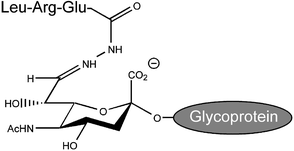Altered cellular response to adsorbed matrix protein by chemoselective ligation of small molecules
Abstract
In the field of tissue engineering, there is a constant drive to develop materials that enable control over cell adhesion, growth and differentiation for optimal tissue development. In many cases, these materials incorporate or are coated with extracellular matrix proteins to increase cell adhesion and spreading. Here we show that chemoselective modification of an adsorbed matrix protein can be used to selectively alter the response of cultured cells. Using the glycoprotein laminin-1, it was shown that oxidation of terminal sialic acid moieties resulted in the generation of aldehyde groups which could be employed to chemoselectively ligate hydrazide-bearing biomolecules. The hydrazide derivative of the tripeptide Leu–Arg–Glu, a “stop” signal for motoneuron outgrowth, was ligated to periodate-treated laminin and shown to inhibit the mean neurite length of primary spinal cord motoneurons by 39% in comparison to controls. These results demonstrate that adsorbed glycoproteins can be readily modified in order to alter the cell response and could enable matrices to be tailored to different cell types.


 Please wait while we load your content...
Please wait while we load your content...